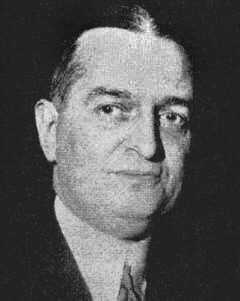Before there was Jimmy Hoffa, before there was even Amelia Earhart, another VIP vanished without a trace. He was a household name to your grandparents, and his disappearance remains New York City’s oldest unsolved Missing Persons case.
On the surface, Judge Joseph Crater looked like a regular guy. A biographer described him as four personalities rolled into one: “A jurist, a professor, a Tammany Hall stalwart, and a family man.” He could have added a fifth: A party boy known as “Good Time Joe” who secretly had a thing for booze (during Prohibition, no less) and showgirls.
New York Gov. Franklin Roosevelt appointed Crater to the state Supreme Court in April 1930. He was 41, married, and, apart from being an unusually spiffy dresser, personified a dignified judge.
Fast forward to that summer. Crater and his wife, Stella, were vacationing in Maine. He got a phone call that troubled him. Crater left on August 3, saying he had to return to New York “to straighten those people out.” He promised to be back by Stella’s birthday on August 9. He was upbeat and behaving normally when he boarded a train that night.
Arriving in the Big Apple the next morning, Crater went to his Fifth Avenue apartment, where he told the maid to take the next few days off. He saw a show that night and lunched with two fellow judges the next day.
Which brings us to Wednesday, August 6.
Crater went to his courthouse office and pawed through records. He asked an assistant to cash two checks for him (from closed stock accounts, he said) totaling more than $5,100 (almost $91,000 today). At noon he headed home with the cash and several files tucked inside two locked briefcases.
That evening, “Good Time Joe” was ready for a night on the town. A lawyer friend and Crater’s secret girlfriend, showgirl Sally Lou Ritz, joined him at a steakhouse. Nothing seemed amiss. After dinner, Judge Crater crawled into a taxi around 9:30. He waved goodbye — and was never seen again.
He had reserved a single ticket for that night’s late performance of a new show called “Dancing Partner.” Someone picked it up, but nobody recalled seeing Crater at the theater.
Back in Maine, August 9 came and went. Stella naturally grew increasingly worried. She called friends and colleagues in the city. No, they hadn’t seen the judge for days. Crater’s seat was empty when the state Supreme Court reconvened on August 28.
Stella finally called the New York Police Department on September 3. Missing Persons file #13595 was opened, the story became front-page news from coast to coast, and the country went Crater Crazy.
What was called the most extensive manhunt since the search for John Wilkes Booth was launched. A $5,000 reward was offered. Cops soon had their hands full, fielding more than 16,000 tips. Crater was spotted panning for gold in California, detained in a Missouri mental hospital, herding sheep out West, shooting dice in Atlanta, and (my favorite) running a bingo hall in North Africa.
Police detectives got busy, and what they turned up astonished even jaded New Yorkers.
A few weeks after his April appointment to the bench, Crater had withdrawn $20,000 from his bank account (worth $300,000 today). But investigators never learned where that money went.
Then there were the mistresses. (Note the plural.) Most intriguing of all was the expensive prostitute Vivian Gordon. New York’s richest businessmen were among her clients.
So, what happened to his honor? Conspiracy theorists offered explanations by the bushel:
—Crater had paid crooked Tammany Hall for his seat on the bench. When they demanded more money, Crater refused and was eliminated.
—Crater had amnesia.
—Franklin Roosevelt, already eyeing a White House run in 1932, wanted him out of the picture.
—Crater ran off to Canada (or Europe, or South America, or any exotic locale of your choice) with yet another hush-hush girlfriend.
—And the perennial answer to almost every unsolved crime in Gotham, gangsters rubbed him out.
The New York City Police Department officially closed the Crater case in 1979.
For years, comics got laughs by saying, “Judge Crater, call your office!” (When one joke bombed particularly badly, Groucho Marx recovered by saying, “I’m going outside to look for Judge Crater.”) For decades “pulling a Crater” described someone who disappeared.
Stella fell on hard times. Without the judge’s salary, she was forced out of their Fifth Avenue apartment. When she asked a court to declare Crater dead in 1937, she lived on $12 a week as a phone operator. She married an electrical contractor in 1938 and finally got the $20,561 life insurance payout ($450,000 today) the next year. She and Husband No. 2 split in 1950.
For the rest of her life, Stella went to a small Greenwich Village bar every August 6, ordered two drinks, lifted one, and whispered, “Good luck, Joe, wherever you are.”

